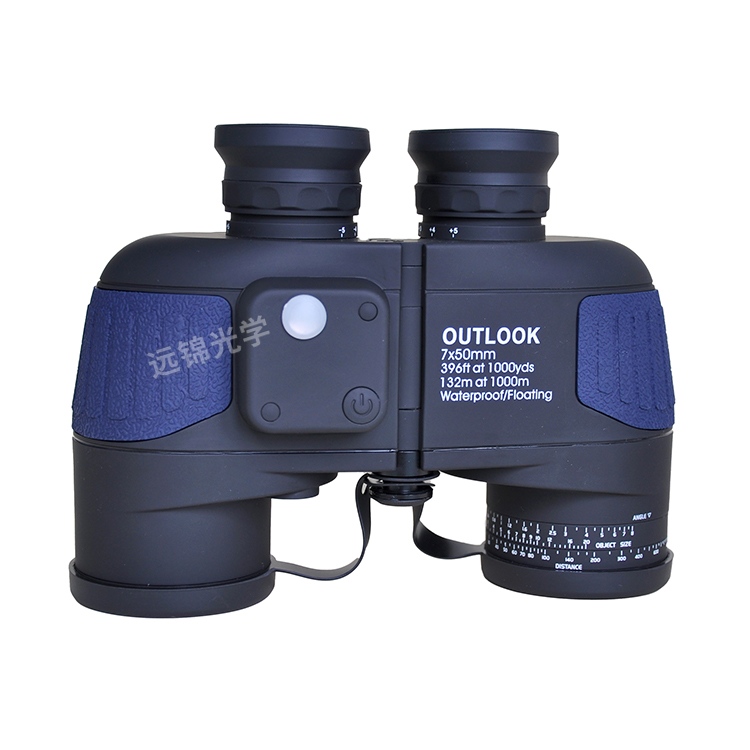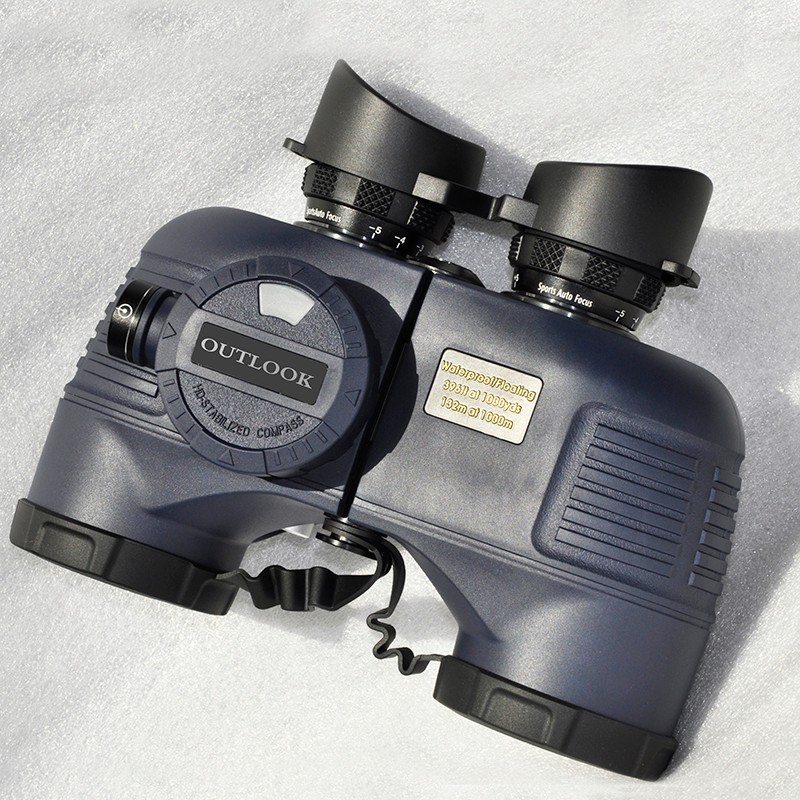Marine telescopes, technically known as shipboard telescopes or marine binoculars, are significantly different from ordinary telescopes used for everyday stargazing or watching TV. Marine telescopes are specialized instruments designed specifically for the harsh marine environment.
I. Core Features of Marine Telescopes: Born for the Ocean
The design of marine telescopes is closely focused on the specific needs of marine use:
High Sealing and Corrosion Resistance (Most Crucial)
Nitrogen-Filled Waterproofing: Most high-quality marine telescopes use a nitrogen-filled process, with the interior filled with inert nitrogen gas to prevent fogging and mold growth on the internal lenses in environments with large temperature differences. The outer shell is rubber-coated or has a special anti-corrosion coating, effectively resisting salt spray corrosion.
O-ring Sealing: Ensures the entire telescope is waterproof, able to withstand splashes from waves and even brief immersion in rain.

Stable Imaging
Image Stabilization Function: This is the "trump card" function of mid-to-high-end marine telescopes. Because ships are constantly in motion, ordinary telescopes struggle to clearly see targets. Image stabilization technology (divided into electronic stabilization and gyro stabilization) effectively counteracts ship movement, providing clear and stable images and greatly reducing eye strain for the observer.
Large Objective Lens: Typically, the objective lens has a larger aperture (e.g., 7x50), collecting more light and ensuring a bright field of view at dawn, dusk, or in poor visibility conditions.
Classic Specification: 7x50
7x Magnification: Moderate magnification. Excessive magnification amplifies ship movement, making observation difficult and narrowing the field of view, hindering target searching.
50mm Objective Lens Aperture: The large aperture ensures ample light transmission and a bright image.
Large Exit Pupil Diameter (approximately 7.14mm): This provides greater tolerance for eye position errors during observation, reducing the likelihood of "shadows" (ghosting) even with ship movement, and making observation more comfortable when wearing glasses.
Therefore, 7x50 has become the most classic and common specification for marine binoculars.
Compass Function: Many professional marine binoculars integrate a digital compass in the right eyepiece. When the observer aims at a target, the target's azimuth is directly displayed in the field of view for navigation, positioning, and risk avoidance. This is a combination of its function as a "marine compass binocular."
Durable Construction: The casing is robust, usually wrapped in rubber, which not only resists corrosion but also provides slip resistance and impact resistance.
II. Main Types of Marine Telescopes:
Standard Waterproof Marine Telescopes: Possess the basic features mentioned above, such as waterproofing, corrosion resistance, and a wide field of view, but lack image stabilization and compass functions. Marine telescopes offer high cost-effectiveness and are the choice of many small boats and amateur sailors.
Stabilized Marine Telescopes: The core technology is image stabilization. They are expensive, but offer a significantly enhanced experience. Marine telescopes are the first choice for professional merchant ships, workboats, coast guard vessels, and high-end sailing ships. Representative brands include Fujinon and Nikon.
Marine Compass Binoculars with GPS: Based on image stabilization telescopes, they integrate a digital compass binoculars can even record the latitude and longitude of the target's location via GPS. These are the most comprehensive and top-of-the-line models.
III. Main Uses of Marine Telescopes
* **Lookout and Collision Avoidance:** Marine compass binoculars can be used for observing waterways, other vessels, buoys, icebergs, and other obstacles; this is the most basic safety function.
* **Navigation and Positioning:** Marine compass binoculars can be used for observing known landmarks such as lighthouses and hilltops on shore, and using compass readings to determine the ship's position.
* **Communication and Identification:** Marine compass binoculars can be used for identifying the names, flag signals, and light signals of distant vessels, or conducting light communication.
* **Fisheries and Research:** Marine compass binoculars can be used for observing schools of fish, marine life, or unusual sea conditions.
* **Emergency Search and Rescue:** Marine compass binoculars can be used in search and rescue missions to locate targets on the sea surface.
Marine compass binoculars generally use a 7x magnification, primarily due to the specific needs of the maritime environment and a balance of optical performance. The main reasons for 7x magnification marine telescope becoming the standard for marine compass binoculars are as follows:

Stability and Comfort of 7x Marine Telescope
In a maritime environment, ships always experience a certain degree of rolling, which cannot be completely eliminated even in calm seas. A 7x magnification marine telescope provides a relatively stable viewing experience, avoiding image jitter and observer dizziness caused by excessively high magnification. If a 10x or higher magnification marine telescope is used, even minor ship movements are significantly magnified, severely impacting viewing quality and comfort.
Optimized Exit Pupil Diameter of 7x Marine Telescope
Exit pupil diameter is an important indicator of telescopes image brightness, calculated as: objective lens diameter ÷ magnification. A 7×50 marine telescope has an exit pupil diameter of 7.1mm, while the maximum pupil diameter of the human eye in low-light conditions is approximately 7-8mm. This configuration ensures that the observer receives a bright and clear image even in low-light conditions at sea, such as dawn, dusk, or overcast skies.
Advantages in Field of View
A 7x magnification telescope offers a significantly wider field of view (FOV) compared to 8x or higher magnification. On the vast ocean, the area to be observed is enormous; a wider field of view means faster observation, enabling quicker target location in maritime rescue operations and improving observation efficiency.
Balance of Weight and Portability
If choosing 8x magnification marine compass binoculars while maintaining a 7mm exit pupil diameter, the objective lens diameter needs to reach 56mm, significantly increasing the telescope's weight (up to 1300 grams or more). In contrast, a 7×50 marine compass binoculars typically weighs between 800-1100 grams, making it easier to hold for extended periods and requiring less physical exertion from the observer.
All-Weather Applicability
The 7×50 configuration meets the needs of all-weather maritime use. The large 50mm objective lens collects sufficient light, ensuring image quality even in low-light conditions, while the 7x magnification ensures observation stability in various sea conditions.
For maritime use, 7x magnification marine compass binoculars remains the preferred choice. This optimal balance is achieved after considering factors such as the swaying characteristics of the maritime environment, observation comfort, image brightness, field of view, and portability. This marine compass binoculars provide reliable optical protection for maritime safety, especially in the challenging environments of the sea where prolonged observation is required and lighting conditions are variable.

In summary, marine compass binoculars are the "eyes" of sailors at sea. Their design is entirely geared towards providing clear, stable, and reliable observation in harsh environments characterized by swaying, humidity, and high salinity. Whether it's a simple 7x50 waterproof compass binoculars or a powerful electronically stabilized compass binocular, it is an indispensable piece of equipment for ensuring safe navigation.
When choosing a marine telescope, you need to consider your vessel type, the waters you are sailing in, and your budget to determine whether you require advanced features such as image stabilization and a compass. For most recreational sailors, a reliable 7x50 waterproof marine compass binocular is already excellent equipment.

